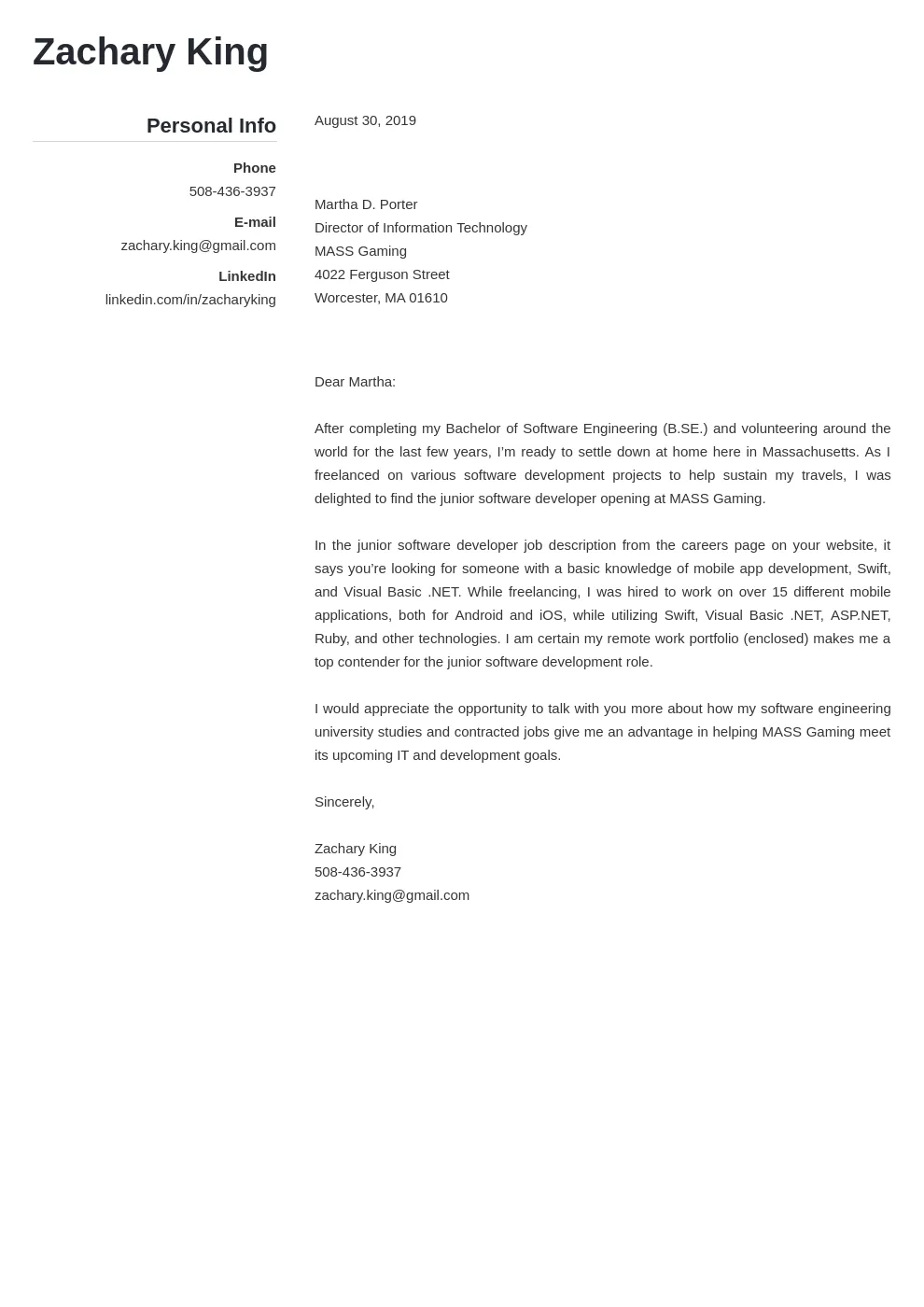Why a Software Engineer Cover Letter is Crucial
In the competitive world of software engineering, a well-crafted cover letter can be your golden ticket to landing your dream job. It serves as your initial introduction to a potential employer, offering a valuable opportunity to showcase your personality, passion, and unique qualifications beyond the confines of your resume. Your resume provides a summary of your skills and experience, but the cover letter is where you breathe life into your application. It’s where you connect with the hiring manager on a more personal level, demonstrating your genuine interest in the company and the specific role. A compelling cover letter can significantly increase your chances of getting an interview, setting you apart from other applicants and making you a memorable candidate.
The Purpose of a Cover Letter
The primary purpose of a software engineer cover letter is to persuade the hiring manager that you are the ideal candidate for the position. It’s not merely a formality, but a strategic tool. Your cover letter allows you to articulate why you’re excited about the role and the company. You can highlight your relevant skills and experience, connecting them directly to the requirements outlined in the job description. This helps the hiring manager quickly understand the value you bring. The cover letter also gives you the space to explain any gaps in your employment history or to provide context for your career choices. Furthermore, it offers a platform to showcase your writing and communication skills, which are critical in collaborative software development environments.
Highlighting Your Technical Skills
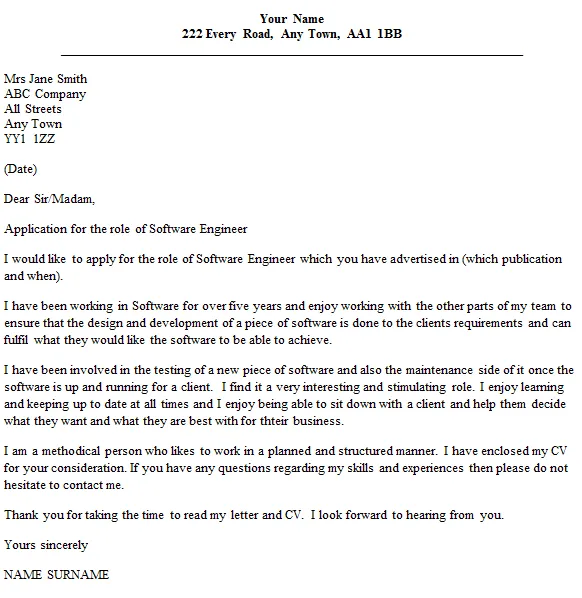
A software engineer cover letter is your chance to put your technical skills on full display. It’s vital to clearly articulate the programming languages, frameworks, and tools you are proficient in. Don’t just list them; provide context. Explain how you’ve used these skills to solve problems, develop projects, or contribute to previous teams. Think about your experience with languages like Python, Java, C++, or JavaScript, and specific frameworks such as React, Angular, or Django. Tailor this section to match the requirements of the job description. If the job posting emphasizes experience with cloud platforms like AWS or Azure, ensure you highlight your relevant expertise. By providing concrete examples, you can demonstrate your competence and make your application more compelling.
Specific Programming Languages and Technologies
In your cover letter, provide specific examples of how you’ve utilized particular programming languages and technologies. Instead of saying ‘I know Java,’ you could write, ‘In my previous role, I utilized Java and Spring Boot to develop RESTful APIs for a high-traffic e-commerce platform.’ This shows practical experience and a deeper understanding. If the job requires experience with specific databases like MySQL or MongoDB, detail projects where you’ve used them. For instance, ‘I implemented a scalable database solution using MongoDB to manage large datasets, resulting in a 30% improvement in query performance.’ This level of detail helps the hiring manager quickly assess your alignment with their tech stack.
Showcasing Your Problem-Solving Abilities
Software engineering is fundamentally about problem-solving, so your cover letter should spotlight your ability to tackle complex issues. Describe specific projects where you encountered challenges and the steps you took to overcome them. This could involve debugging a particularly tricky piece of code, optimizing a system for performance, or developing innovative solutions to meet project requirements. When describing your problem-solving skills, use the STAR method (Situation, Task, Action, Result). For example, ‘In a project to improve website loading times (Situation), I was tasked with identifying and fixing performance bottlenecks (Task). I analyzed code, optimized database queries, and implemented caching (Action), resulting in a 40% reduction in page load times (Result).’ This format clearly demonstrates your ability to assess situations, take action, and achieve results.
Quantifying Your Achievements
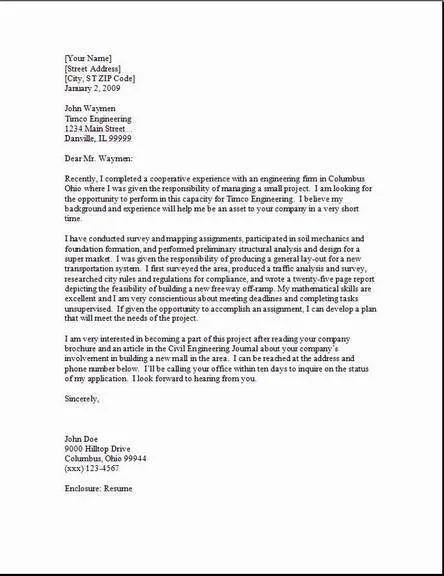
Quantifying your achievements is a powerful way to make your cover letter stand out. Instead of just saying you improved efficiency, provide specific numbers. Did you reduce development time by a certain percentage? Did your code result in a measurable improvement in system performance or user satisfaction? Include data that demonstrates the positive impact of your work. This could involve metrics like reduced bug reports, increased customer engagement, or cost savings. For instance, ‘By implementing a new testing strategy, I reduced the number of production bugs by 25%.’ These specific, measurable results make your accomplishments more credible and compelling, allowing the hiring manager to quickly understand the value you can bring to their team.
Adding Numbers to Your Achievements
Incorporating numbers into your achievements gives concrete proof of your capabilities. For instance, instead of saying ‘I improved code quality,’ you might write, ‘Implemented code reviews that reduced critical bugs by 30%.’ Or, ‘Managed a team of five developers to deliver a project ahead of schedule.’ These figures highlight your accomplishments and demonstrate your impact. Consider the specific goals and KPIs (Key Performance Indicators) that are important in software development, and provide data that aligns with those measures. This makes your cover letter more persuasive and demonstrates your focus on achieving results. Make sure your numbers are accurate and verifiable, and always provide context to explain your role in achieving these outcomes.
Demonstrating Soft Skills
While technical skills are critical, soft skills are equally important for success in software engineering roles. Your cover letter should highlight abilities like communication, teamwork, and problem-solving. Show how you collaborate with others, manage conflicts, and contribute to a positive team environment. These skills demonstrate your ability to work effectively with colleagues and your understanding of the broader goals of the organization. Employers seek candidates who can not only write code but also communicate effectively, adapt to change, and contribute to a supportive team culture. Mentioning these soft skills, along with relevant examples, enhances your overall profile.
Communication Skills
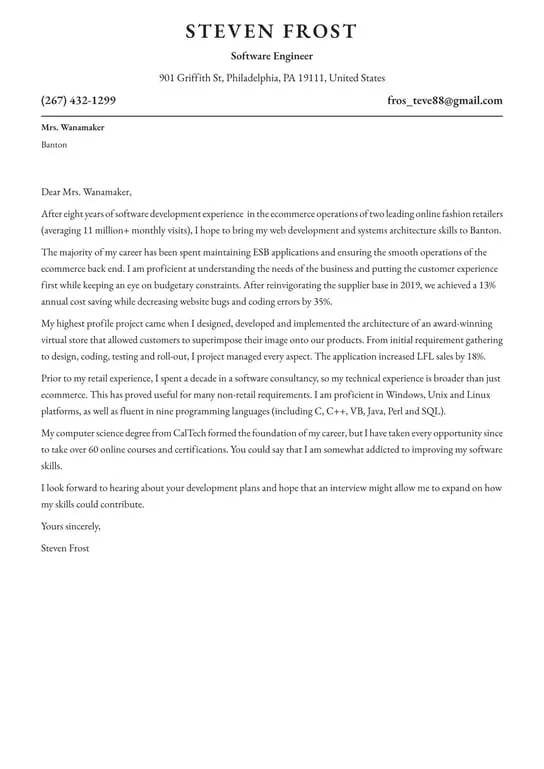
Effective communication is essential for a software engineer. In your cover letter, provide examples of how you convey technical concepts clearly to both technical and non-technical audiences. For example, describe instances where you presented project updates to stakeholders or explained complex technical issues to team members. Detail any experience with writing technical documentation, creating user guides, or delivering training sessions. Strong communication helps reduce misunderstandings, facilitate collaboration, and keep everyone aligned on project goals. Show your ability to listen actively, provide constructive feedback, and adapt your communication style based on the audience.
Teamwork and Collaboration
Software development is often a team effort. In your cover letter, emphasize your collaborative abilities. Provide specific examples of how you’ve contributed to team projects, collaborated with other engineers, and shared your knowledge. Describe any experience with agile development methodologies, pair programming, or code reviews. Highlight instances where you’ve helped resolve conflicts, offered constructive feedback, or supported your colleagues. Show your ability to work effectively within a team, respect different viewpoints, and contribute to a positive and productive work environment. Your ability to be a team player will significantly enhance your chances of being hired.
Tailoring Your Cover Letter
Avoid sending a generic cover letter. Customizing your letter for each job application significantly increases your chances of success. Research the company and the specific role to understand their needs and culture. Examine the job description carefully and identify the key skills and qualifications the employer is seeking. Then, tailor your letter to demonstrate how your experience and skills align with those requirements. Address specific projects, technologies, or challenges that resonate with the job description, showing your understanding of the role and the company. By personalizing your cover letter, you make it clear that you’re genuinely interested in the opportunity and have the right skills to contribute.
Researching the Company
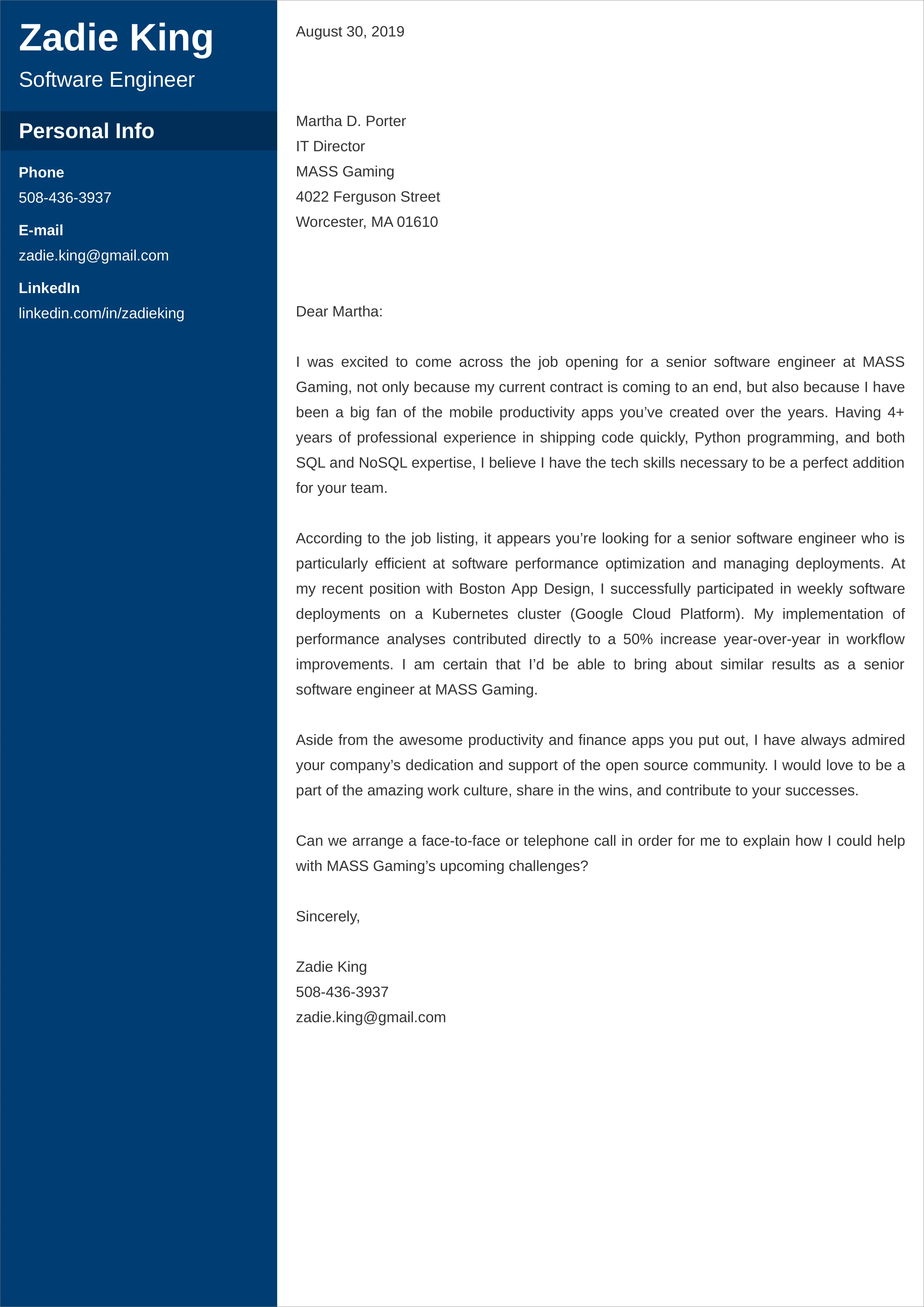
Before writing your cover letter, invest time in researching the company. Visit their website, read their blog, and check out their social media profiles to learn about their products, services, values, and culture. Look for recent news articles or press releases to understand their current projects and initiatives. Tailor your letter to reflect your understanding of the company’s mission and goals. Show that you’ve taken the initiative to learn about the organization. Mention specific projects or technologies that align with the company’s focus and demonstrate your interest in contributing to their success. This research not only helps you personalize your letter but also allows you to assess whether the company aligns with your own career goals and values.
Matching Skills to Job Requirements
Carefully analyze the job description and identify the skills and qualifications the employer is seeking. Make a list of the key requirements, and then map your own skills and experiences to those needs. In your cover letter, clearly demonstrate how your skills align with the job requirements. Use the same keywords and phrases from the job description. Provide specific examples of how you’ve used these skills in the past, and how you can apply them to the role. Tailor your letter to highlight the experiences and accomplishments most relevant to the position. This will help the hiring manager quickly see that you have the skills and expertise they are looking for.
Formatting and Style
The formatting and style of your cover letter are just as important as the content. Use a professional and easy-to-read format. Choose a clean, simple font like Arial or Times New Roman, and use a font size between 10 and 12 points. Use clear headings and subheadings to break up large blocks of text, making it easy for the reader to scan. Keep the letter concise and to the point, typically no more than one page. Proofread carefully for any errors in grammar or spelling. A well-formatted cover letter demonstrates attention to detail and professionalism. Use strong action verbs and active voice to make your writing more engaging and dynamic.
Professional Formatting Tips
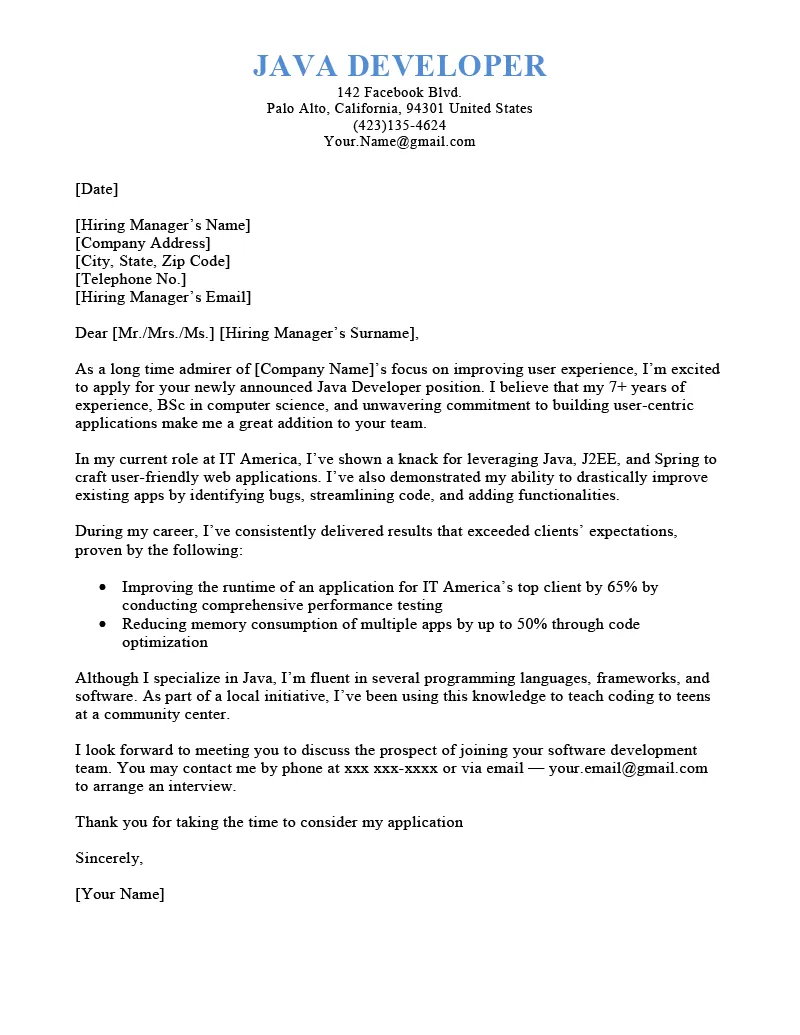
When formatting your cover letter, pay attention to several key details to ensure a professional appearance. Use consistent formatting throughout the document. This includes font style, size, spacing, and alignment. Use a professional letterhead if you have one. Include your contact information at the top, such as your name, phone number, email address, and LinkedIn profile URL. Use a clear and logical structure, with an introduction, body paragraphs, and a closing. Keep paragraphs short and focused, and use bullet points to highlight key skills or achievements. Use white space effectively to avoid a cluttered appearance. Proofread the entire document multiple times, and have someone else review it to catch any errors.
Proofreading and Editing
Proofreading and editing your cover letter is a crucial step that can make or break your application. Errors in grammar, spelling, and punctuation can create a negative impression and undermine your credibility. Before submitting your cover letter, read it carefully multiple times. Use a spell-checker and grammar-checker, but don’t rely on them entirely. Proofread each sentence carefully to ensure it is clear and concise. Have someone else review your cover letter. A fresh pair of eyes can often catch errors that you might miss. Ensure that your language is professional, and that your tone is appropriate for the job and company. By taking the time to proofread and edit, you can demonstrate attention to detail and professionalism.
Common Mistakes to Avoid
Several common mistakes can significantly reduce the effectiveness of your cover letter. Avoid sending a generic cover letter; customize it for each job. Don’t simply repeat your resume; the cover letter should complement and expand on the information in your resume. Avoid using overly complex language or jargon. Keep your writing clear and concise. Do not include any negative information or complaints about previous employers or jobs. Avoid being overly informal or casual in your tone. Ensure that your cover letter is free of errors in grammar, spelling, and punctuation. Remember to tailor your letter to the specific role and company. Make sure all contact information is correct and up-to-date. These simple steps can prevent your application from being rejected.
Generic Cover Letters
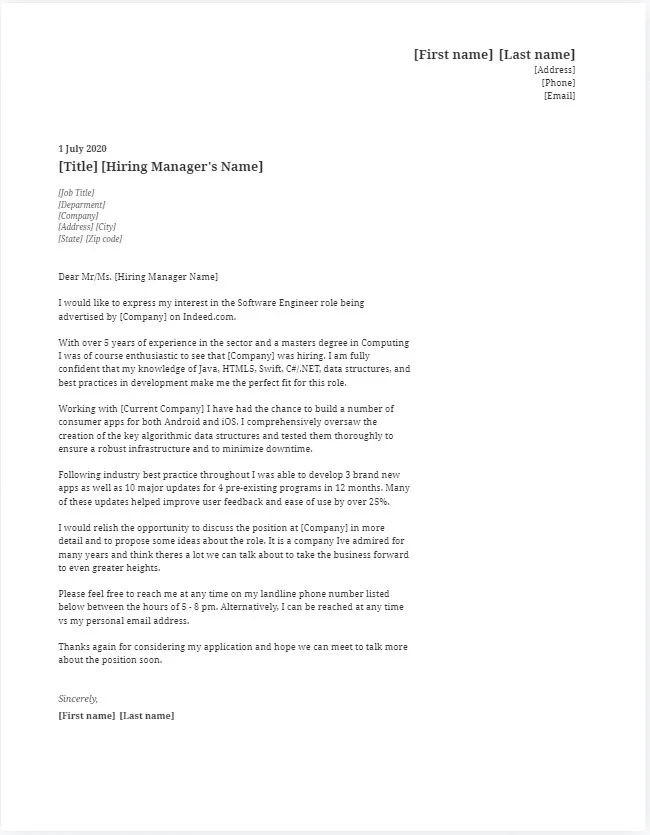
One of the biggest mistakes is sending a generic cover letter that could be used for any job. Generic cover letters often lack the personalization needed to impress a hiring manager. They fail to demonstrate your genuine interest in the company and the specific role. Always tailor your letter to the job requirements and company culture. Research the company, and customize your letter to reflect your understanding of their needs and goals. Mention specific projects or technologies that align with the company’s focus, showing your interest in contributing to their success. A personalized cover letter shows initiative, attention to detail, and a sincere interest in the opportunity.
Typos and Grammatical Errors
Typos and grammatical errors can significantly detract from your cover letter. They can create a negative impression of your attention to detail and professionalism. Before submitting your cover letter, carefully proofread the entire document multiple times. Use a spell-checker and grammar-checker, but don’t rely on them entirely. Read each sentence carefully to ensure it is clear and concise. Have someone else review your cover letter. A fresh pair of eyes can often catch errors that you might miss. Errors can make you appear careless or unpolished, so take the time to eliminate them before submitting your application.
The Call to Action
Include a clear call to action in your cover letter to encourage the hiring manager to take the next step. Explicitly state that you want an interview. Express your enthusiasm for the role and the opportunity to discuss your qualifications in more detail. Make it easy for the hiring manager to contact you by reiterating your contact information. A call to action indicates your proactive attitude and makes the application process more engaging. Make it clear that you are eager to learn more and ready to contribute to their team. By including this, you increase your chances of progressing in the hiring process.
Expressing Enthusiasm
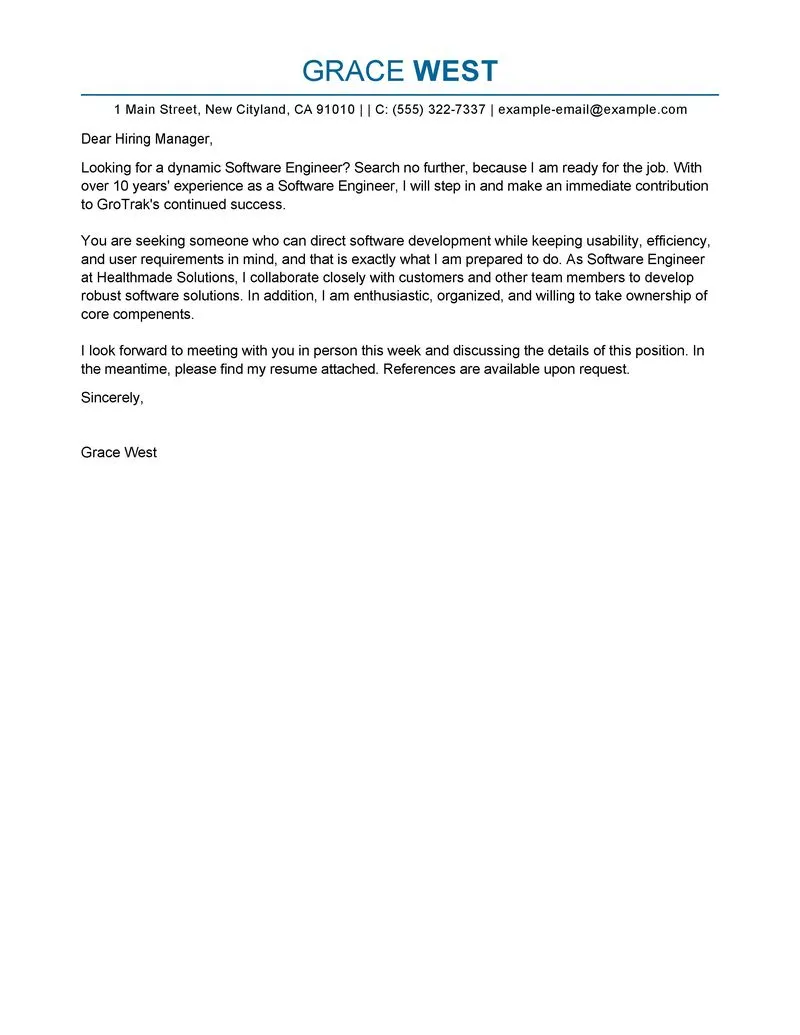
Show your enthusiasm for the role and the company. Your excitement will make a positive impression on the hiring manager. Use strong and positive language to describe your interest in the position and the company’s mission. Mention specific aspects of the job that excite you, such as working with a particular technology or contributing to a specific project. Highlight what you like about the company’s culture, products, or values. A sincere expression of enthusiasm can significantly increase your chances of standing out and getting an interview. Your passion and interest can separate you from other applicants.
Closing and Contact Information
Conclude your cover letter with a professional closing and provide your contact information. Use a formal closing, such as ‘Sincerely,’ or ‘Best regards.’ Then, include your full name, phone number, email address, and LinkedIn profile URL. Make sure your contact information is accurate and up-to-date. This allows the hiring manager to easily contact you if they are interested in your application. Also, express your gratitude for their time and consideration. A strong closing, along with accurate contact information, leaves a positive and professional impression, further increasing your chances of getting an interview and landing the software engineer role.
